Chinese evergreen plant is also known as Aglaonema. This classic indoor plant is native to Asia and comes in several exciting varieties.
The stunning color variations and easy maintenance make this ornamental houseplant quite popular. It makes the novice gardeners look like experts when growing them.
Aglaonema plant is a slow-growing and attractive indoor foliage plant. You can plant Chinese evergreens in any room due to the ability to tolerate low light.
The Chinese evergreen plant care routine is super easy. Aglaonema plants thrive under bright indirect sunlight, a temperature of about 65-80°F, moderate soil moisture, high humidity, light-acidic soil in a range of 5.6-6.5 pH, and well-drained pot mix.
You need to keep an eye on sunlight, soil conditions, pests, and diseases to help the houseplant reach its full potential. Keep in mind that all the Chinese evergreen varieties have the same requirements.
Today I am going to show you how to take care of Chinese evergreen like an expert. You will also get to know the Chinese evergreen benefits along the way. Take the time to read through the entire guide for better results.
You May Also Enjoy: How to Grow and Care for Spider Plant
What Does A Chinese Evergreen Plant Look Like?
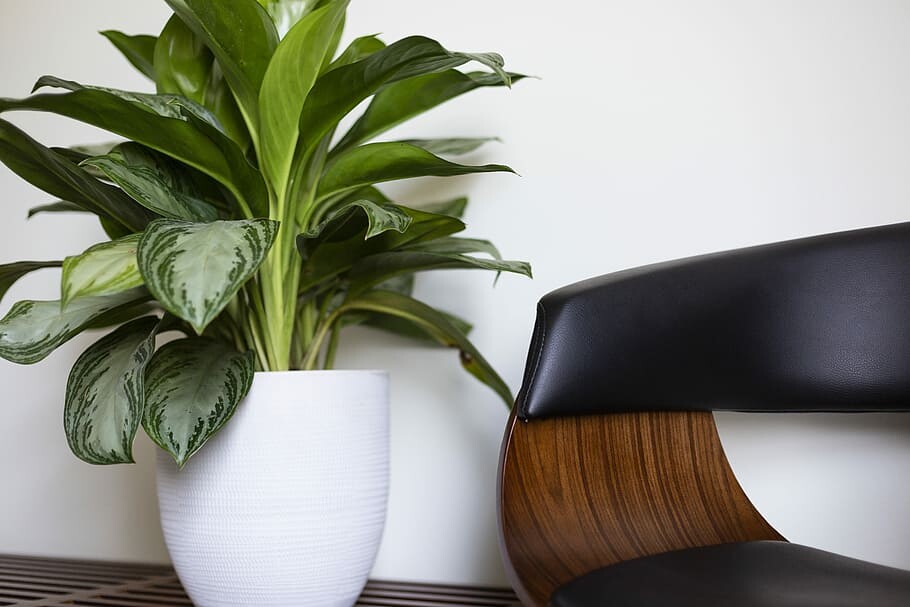
Aglaonema is an herbaceous perennial plant. This tropical foliage plant is native to Asia and it usually reaches a height of 2-3 feet.
The common names of Aglaonema plants are Chinese evergreen and Philippine evergreen. It belongs to the Araceae family.
The Chinese evergreen produces glossy variegated leaves that are about 9-12 inches long. The foliage can either be solid green or silver with stunning white markings along the primary veins.
Older Philippine evergreens usually bloom during late spring and summer. The houseplant was first introduced in the United States around the 1800s.
This ornamental indoor plant has grown in popularity and spread to many countries in Europe as well as Australia. The plant is beautiful, adaptable, and easy to grow in any condition.
Continue reading this Chinese evergreen care guide for more detailed insight. We have outlined some care tips and Chinese evergreen benefits in your home.
You May Also Like: 20 Beautiful Aglaonema Varieties with Names and Pictures
Chinese Evergreen Plant Care Details
| Origin (Native Habitat) | Subtropical Rainforest of Malaysia, Indonesia, and the Philippines. |
| Scientific Name | Aglaonema commutatum. |
| Common Names | Chinese Evergreen and Philippine Evergreen. |
| Family | Araceae family. |
| Maximum Growth (Approx.) | Height: 2-3 feetLeaf Length: 9-12 inches long |
| Chinese Evergreen Varieties | Aglaonema ‘Red Gold’Aglaonema ‘Suzy’Aglaonema ‘Silver King’Aglaonema ‘Silver Queen’Aglaonema ‘Harlequin’Aglaonema ‘Emerald Bay’Aglaonema ‘Cutlass’Aglaonema widuri, ‘Red Peacock’Aglaonema nitidumAglaonema modestum |
| Watering Needs | Moderate moisture soil |
| Light Requirement | Low to moderate.(Can tolerate bright indirect sunlight for short period) |
| Humidity | High humidity |
| Soil | Slightly acidic. (Range of 5.6-6.5 pH) |
| Fertilizer | Gentle liquid fertilizer.(Apply during spring and summer) |
| Season | Perennial plant |
| Temperature | 70-85oF |
| Flowering | Bloom in late spring and summerProduce white flowers. |
| Pruning | Experience slow-growth. (No pruning.) |
| Propagation | Division |
| Hardiness Zone | 10–12 (USDA) |
| Pests | Mealybugs, Spider Mites, and Aphids |
| Diseases | Leaf spots and Root rot |
| Toxicity | Toxic to dogs and cats |
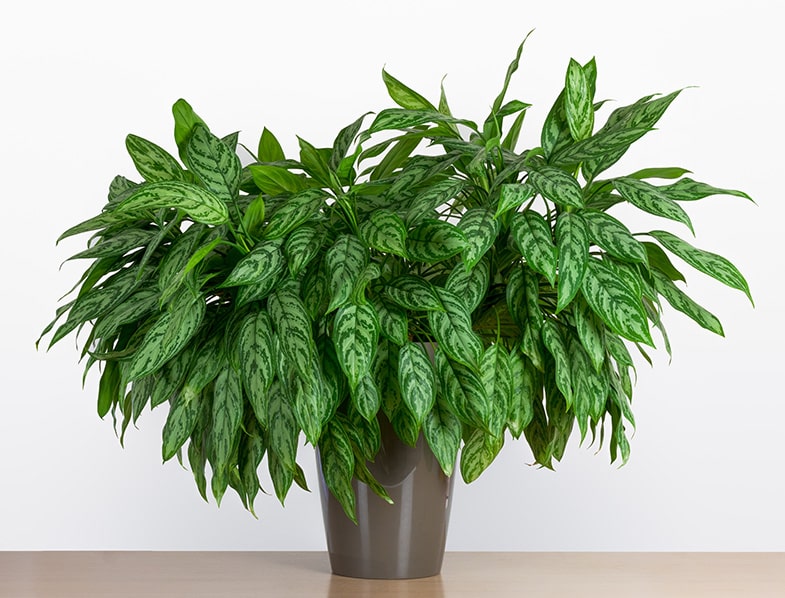
How to Care for A Chinese Evergreen Plant
There are about 14-21 species of Chinese evergreen varieties. All aglaonema varieties are easy to grow and maintain in any condition. Aglaonema Silver Queen is the most popular and perfect option for office space.
Below are guidelines on how to grow and care for aglaonema plants. Take time to read through it and provide the required growing condition.
Can Aglaonema Survive Cold?
Chinese evergreens are quite sensitive to cold conditions. The indoor plant will display signs of cold damage when placed in a location where the temperature is below 60oF.
Aglaonema plants experience better growth when the indoor temperature is maintained at 65-85oF. Any temperature above or below the required level will ruin the houseplant’s health.
Extreme high temperatures above 85oF make the indoor plant wilt, droop leaves and even turn brown along the edges.
So, can aglaonema survive cold? No. I recommend keeping the plant away from the heater, air vents, and cold drafts. These growing conditions usually affect the well-being of the plant.
Does Aglaonema Need Sunlight?
The natural habitat of the Philippine evergreen is a subtropical rainforest. The region receives low-moderate sunlight rays penetration due to the canopies of the trees.
Aglaonema plants can tolerate low to moderate sunlight. Create excellent growing conditions at home that mimic their natural habitat.
Variegated aglaonema varieties prefer bright indirect sunlight. The plant can also survive under fluorescent light if not placed near the window.
So, does aglaonema need sunlight? Absolutely. This subtropical plant requires low to moderate sunlight. These plants grow beneath tropical trees in their natural environment.
Direct exposure to sunlight will make aglaonema leaves scorched and drooped. But the plant can survive under bright indirect sunlight for a short period.
Always choose a spot in your house that receives low to moderate light. Such an environment guarantees better growth and well-being of your houseplant.
You Can Also Read: Why Are My Chinese Evergreen Leaves Curling?
What Soil is Best for Aglaonema?
Aglaonema plant thrives in well-drained soil. The soil should also hold moderate moisture to help the herbaceous stems of the plant maintain an upright posture.
A pot with drainage holes helps to get rid of excess water. The trick helps to reduce the risk of root rot damage. The disease makes the plant leaves turn yellow and brown in the long run.
The soil should also be loose to enhance proper aeration. Keep in mind that the houseplant loves nitrogen-rich soil. Avoid planting aglaonema in densely packed soil.
So, what is the best soil for aglaonema? Lightly acidic soil in the range of 5.6-6.5 pH. The slight acidic soil allows the plant to flourish without facing any problems.
Do Chinese Evergreens like to be Misted?
The natural habitat of Chinese evergreen has a high humidity level. The plant can absorb the moisture from the air to help maintain its herbaceous stems.
So, do Chinese evergreens like to be misted? Absolutely. The indoor growing conditions are dynamic and misting the plant is highly recommended to increase the humidity level.
You can also place the houseplant in a pebble tray with water to help increase humidity. Ensure the growing condition at home mimics their natural habitat.
Do not place the plant near the drafts and air conditioners. The houseplant cannot survive under cold conditions since it causes leathery foliage.
You May Also Like: How to Grow and Care for Peperomia Plant
How Do You Make Aglaonema Grow Faster?
Aglaonema is not a heavy feeder like any other houseplant. Proper fertilizer application provides nutrients that foster faster growth.
Keep in mind that aglaonemas are slow-growing plants. You need to exercise patients and provide a better growing condition for your plant.
So, how do you make aglaonema grow faster? Apply gentle liquid fertilizer once or twice a month throughout the growing season (summer and spring).
Do not fertilize your houseplant during winter since the growth is dormant. Overfertilization will result in toxic buildup around the root system and this will damage your plant.
Underfertilization results in insufficient nutrients supply to the plant. Your aglaonema leaves will begin turning yellows and developing leggy stems.
How Much Water Do Chinese Evergreens Need?
The subtropical rainforest where aglaonema plants grow receives a moderate amount of rainfall. The soil type is loam and well-drained to prevent waterlogging and soggy soil.
Soggy soil increases the risk of root rot damages. The issue usually causes yellow or brown leaves on aglaonema plants. Reviving the plant can be a little bit tricky to some extend.
So, how much water do Chinese evergreens need? Low to moderate. Aglaonema is tolerant to low water conditions for a short period. Always inspect the soil moisture content before watering.
Underwatering and overwatering stress usually affect the houseplant in a negative way. Insert your index finger to about 2-3 inches to confirm if it is dry.
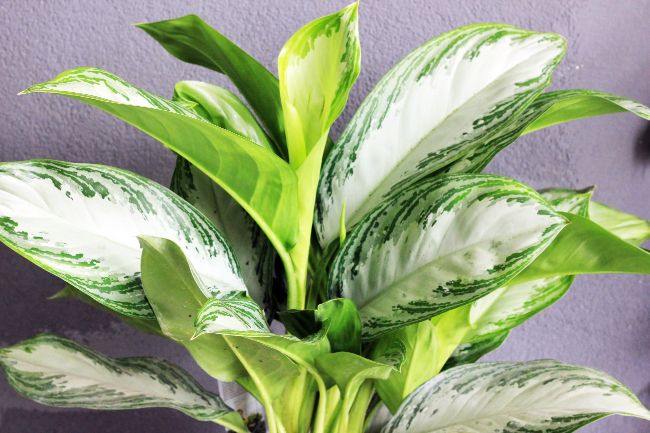
How Do You Propagate Aglaonema?
Propagating Chinese evergreen is super easy since the plant does not experience a tough time when sprouting roots. Below are the steps to consider when propagating aglaonema:
- Get a sterilized pair of scissors or a sharp knife.
- Snip off a few inches of stems.
- Collect the cuttings and place them in a cup of water.
- Place the cup on a window sill where there is indirect sunlight.
- Wait for the roots to sprout and transfer to potting soil.
- Water the pot and provide favorable growing conditions.
How Do You Know When to Repot a Chinese Evergreen?
Aglaonema should be repotted to fresh potting mix every two years. Repotting helps to replenish the soil and also divide the plant due to an increase in size.
Chinese evergreens love to have secured and dense roots. Ensure the container is of proportionate size to the plant.
- Pick a larger pot than the current one.
- Use a shovel to dig out your aglaonema plant.
- Break up the roots if they are tangled and constricted.
- Place the plant in a new pot and fill it with fresh pot mix.
- Water the plant and allow it to adjust to the new condition.
When Should Aglaonema Be Pruned?
Aglaonema is a slow-growing houseplant. There is no need to worry about pruning. But you should remove the old foliage to redirect energy and nutrients to new growths.
Do not prune the leggy live growths. You can remove the above nodes to encourage your aglaonema to become bushy.
You should also prune off the aglaonema flowers since they are not pretty. These flowers also use up excess energy and nutrients which affect the foliage growth.
Remember to trim the flower stalk before the buds begin to open. It will help to prevent scattering the pollen grains everywhere.
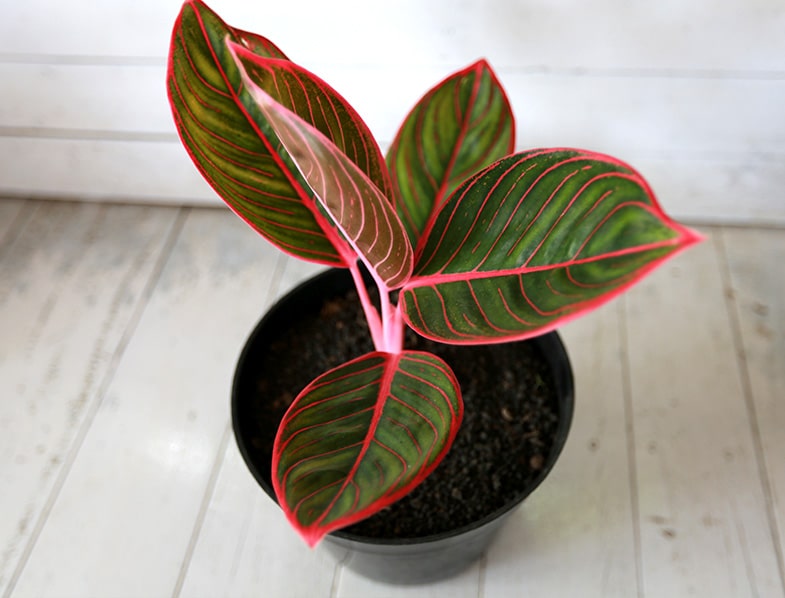
Common Aglaonema Problems and How to Fix Them
Pest Infestations
Mealybugs are the most common pests infesting the aglaonema plant. These insects attach themselves to the leaves and suck the cell sap. The piercing also damages the leaves.
Scale insects are other pests that damage the aglaonema leaves. Spider mites and aphids are less common culprits on the aglaonema leaves.
Misting the leaves with safe insecticidal soap will help eliminate these pests. Always inspect your houseplant leaves more often and spray them with insecticidal soap every evening.
Diseases
Aglaonema plants are highly susceptible to anthracnose and myrothecium leaf spots. These diseases usually discolor the leaves and cause brown patches or holes.
Severe development of these bacterial diseases might damage your houseplant beyond repair. The best option is to lightly mist the plant with liquid copper fungicide at dusk to allow it dry.
Avoid using non-sterilized tools when pruning the plant leaves. Aphids and non-sterilized tools are responsible for leaf spots formation.
Overwatering the plant also result in root rot problem. The best option is to inspect the moisture content in the soil before watering. Use a container with drainage holes to get rid of excess water.
Chinese Evergreen Care Tips
The main problem affecting Chinese evergreens is yellow leaves. It occurs due to pest infestations, diseases, underwatering, nutrient deficiencies, and more.
Be sure to re-pot the houseplant every two years and provide the required growing conditions to prevent aglaonema yellow leaves issues.
Ensure the foliage receives bright indirect sunlight for a short period. Direct exposure to sunlight would scorch the leaves.
Keep in mind that there are some Chinese evergreens that can tolerate very low light. Choose the variety that will suit your indoor growing condition.
Popular Aglaonema Varieties
Below are some of the main Chinese evergreen varieties:
Aglaonema Silver Bay
The most stunning variegated aglaonema plant ideal for office spaces. It has silver and light green foliage that makes many people fall in love with it.
The leaves are also glossy and oval in shape. The aglaonema variety grows faster when compared to other cultivators. It is easy to grow and maintain.
Aglaonema Chocolate
The dark chocolate green foliage with striking red veins makes this aglaonema cultivator the most attractive on the office desk and living lounge space.
The plant makes a bold statement in the house despite putting it in a dull place. But this aglaonema variety is quite rare and difficult to find.
Aglaonema Prestige
This aglaonema cultivar is the best choice for those individuals that love pretty things. It has leaves splattered with hues of green, cream, pink, and red.
The stems have a vibrant pink shade to provide additional beauty and charm. You can place the plant in a room with white decor to pop the color.
The aglaonema species is readily available and it is super easy to grow. If you are looking to receive compliments from friends, consider this aglaonema cultivar.
Aglaonema Silver Queen
The aglaonema cultivar has silver and green variegated foliage. The regal and classy appearance makes the plant looks like a real queen.
If you are into lush and tropical vibes, consider the aglaonema silver queen variety. The stems grow in clusters to make this beauty an excellent option for you.
Aglaonema Creta
This colorful aglaonema creta is a perfect option for those individuals looking for something lush and elegant for their spaces.
The opulence and effortless charm make this houseplant ideal for bedroom, living room, study place, and even office space. It is undemanding and suitable for novice to grow and maintain.
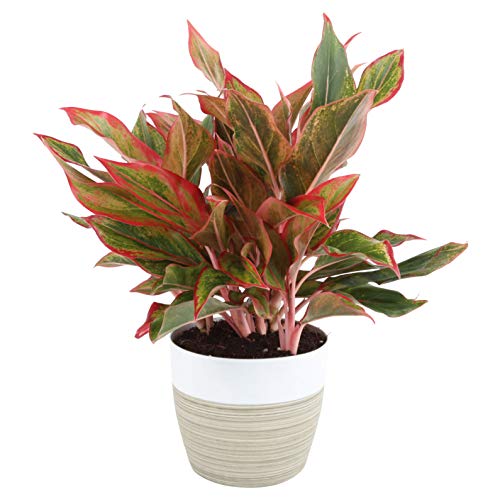
Frequently Asked Questions
How Much Light Does a Chinese Evergreen Need?
Aglaonema cultivars prefer low to moderate light. But you can still place the plant in a region that receives bright indirect sunlight for a short period. Direct sunlight exposure may cause leaf burn and brown patches.
Are Chinese Evergreen Easy to Grow?
Absolutely. Chinese evergreen can adapt to all growing conditions. The tolerance features make novice gardeners like experts when growing them. The houseplant can survive under low water and light conditions.
Is The Chinese Evergreen Plant Poisonous?
Yes. The foliage contains calcium oxalate crystals. These chemical ingredients might cause skin irritation and even death of your pets when ingested.
The houseplant does not pose any dangers to humans. But we recommend keeping the plant away from toddlers or children.
Symptoms of pet poisoning after ingesting the leaves are vomiting, drooling, and difficulty in swallowing. Ensure your dogs or cats do not come close to the plant.
Is Chinese Evergreen a Lucky Plant?
According to Feng Shui customs, Chinese evergreens are known for bringing great fortune. The ease of growth, longevity, and striking appearances are believed to foster well-being and financial success in the family.
Does Chinese Evergreen Clean Air?
Absolutely. The houseplant help to remove formaldehyde and benzene from the air. It is the reason why many people place them in the bedroom and office spaces.
How Do You Make Chinese Evergreen Bushy?
Pruning the best option for making your aglaonema cultivar bushy. Remember that these houseplants experience slow growth and pruning might not be necessary. Remove the nodes to encourage healthy growth and rejuvenation.
Why Do Chinese Evergreens Turn Yellow?
Yellow leaves on Chinese evergreens are due to overwatering, low light, aging foliage, and more. The yellowing of leaves is the main sign of plants experiencing stress. If it affects the lower foliage, there is no need to worry since it is due to aging.
I have written an article explaining why do aglaonema leaves turn yellow. Take the time to read through the article for comprehensive insight and learn how to fix the problem.
Can I Grow Chinese Evergreen in Water?
The technique is only applicable when propagating the aglaonema cultivar. Growing the Chinese evergreens in water will cause root rot damage and this might ruin the well-being of your houseplant. We place the aglaonema stem cuttings in the water container for roots to sprout before transplanting them.
How Do I Fix An Overwatered Chinese Evergreen?
You need to re-pot the plant into a new fresh potting mix. Inspect the roots to not any sign of root rot and snip off the affected roots using a sterilized pair of scissors.
Use a proportionate pot with drainage holes to get rid of excess water. Check the soil moisture content before watering your plant.
Why Do Chinese Evergreen Leaves Turn Brown?
Brown leaf tips and edges on Chinese evergreen is due to underwatering and direct exposure to sunlight. Other causes are improper fertilization and subjecting the houseplant to low humidity for an extended period.
Why Are My Chinese Evergreen Leaves Curling?
Chinese evergreen leaves curling could be due to pest infestation, direct sunlight exposure, low humidity, and underwatering. Temperature stress can also make the plant limpy and become droopy.
I have written an article explaining why your Chinese evergreen is limping and drooping. Take the time to read through it and learn how to fix the problem.
Why is My Chinese Evergreen Flowering?
It is a sign of the aging process. Only older Chinese evergreen plants do experience bloom at some point in their life stage. The best option is to remove the flowers to redirect the energy and nutrients to new growths.
Conclusion
Chinese evergreen plant care is a no-brainer routine. You do not need to have the experience to grow aglaonema cultivars at your home.
All the aglaonema varieties are super easy to grow and maintain. The houseplant can adapt to any growing condition without any problem.
Yellowing and curling of leaves the main problems affecting the houseplant. The good news is that fixing these problems is super easy.
Chinese evergreens can be grown by both newbies and experienced gardeners. They require minimum maintenance routines when compared to other popular houseplants.
More Sources and References
- Editor. Plant Identification Module. The University of Florida.
- Veterinarian Advice. Chinese Evergreen Toxic to Pets. ASPCA.